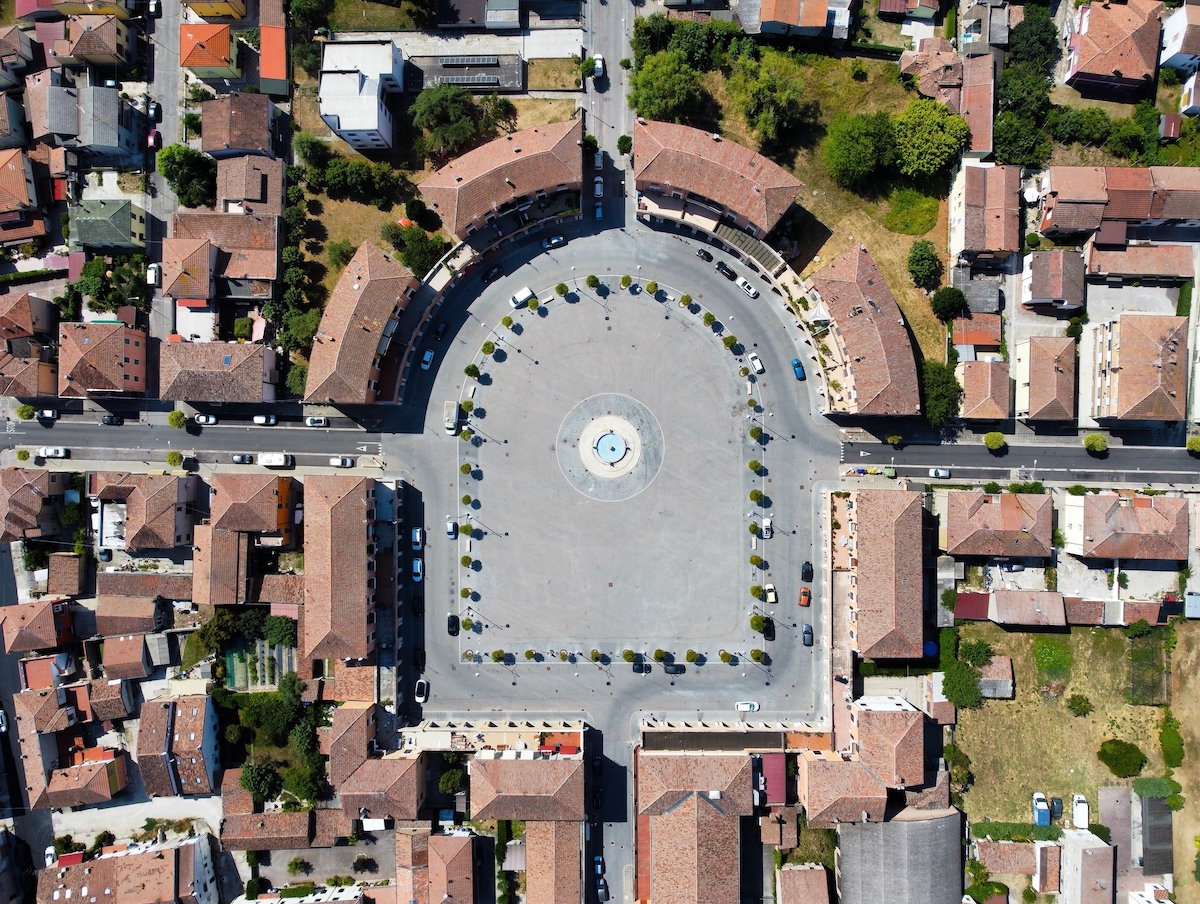Tresigallo is a twentieth century town and a small capital of Italian Rationalism, the successful attempt at very modern town planning.
Tresigallo in fact, is an ancient town of medieval origin. Its most important period however, started from the 1930s, when Edmondo Rossoni, an inhabitant of the town and the Minister of Agriculture in Mussolini's government, transformed it according to the canons of rationalist architecture.
It is one of the few examples of a foundation city to be recognised as a “City of art”.

We start from Via del Lavoro where there is a building on which there is a large sign “SOGNI” (Dreams), one of the symbols of the metaphysical city.
Now called Urban Center, this building was originally intended as a dressing room and baths for young people belonging to the propaganda formations of the regime. This aim, however, was only for a few years, as the building was then abandoned.
Over time, it was repurposed and became a refuge for displaced people during the Second World War.
A little further on is the present library, the House of Culture.
It is the former house of the Italian Youth of the Lictor (Gioventù Italiana del Littorio, G.I.L.), and the first Casa del Balilla, where young people received both physical and ideological training.
It contained a gymnasium, the pre-military education office and a driving school.
The Cooperative theatre was built between 1933 and 1939 by workers from Tresigallo belonging to the Società Immobiliare Operai.
Edmondo Rossoni brought famous opera to the theatre, hosting among others the orchestra of Rome's Teatro dell’Opera conducted by Mario Mascagni. Today, the building is the home of the well-known Philharmonic Band.
What is now the Carabinieri station was once the headquarters of the local National Fascist Party and is one of the most representative buildings of the regime.
The monumental building, typical of regime architecture, is located in a strategic position in the town; it is characterized by the offset of the volumes of the facade and the use of Roman travertine.
The original eighteenth-century facade of the church of Sant'Apollinare, of Romanesque origin (1044 AD), is also covered with travertine and enriched with marble bas-reliefs and monumental decorations.
The church’s colonnade on the other hand, is characterized by an elegant curvilinear structure made of reinforced concrete finished with grain plaster.
The upper part of the colonnade is decorated with a long sequence of stone tiles that depict symbols of the agricultural culture of the area.
Another major symbol of rationalism that can be found in Tresigallo is the monumental entrance to the sports field, which is home to the local team.
A true scenic backdrop, an expression of the classical Roman spirit that the regime wanted to recapture. It is also made of travertine marble and without decorations.
It was originally flanked by a now demolished gateway that once joined it to the elementary school. The building also included a flat for the caretaker of the sports field, therefore being functional as well as monumental.
Once called Piazza della Rivoluzione, it is now known as Piazza della Repubblica.
It is located on the urban axis that symbolically connects the place of work (industrial area) with the place of commemoration (the cemetery).
This is the true centre of the town and appears as an incredibly large imperfect hemicycle. It has high colonnades, intended for buildings, which according to Rossoni were to be used by the town's citizens, and included the Theatre, the only public building having a collective function.
Looking at the hemicycle towards Via del Mare, we can notice two important buildings. The building on the right was built by INA Assicurazioni and the one on the left by Assicurazioni Generali.
Some symbols are still recognizable on the pavement and on the facade of the portico, where the Lion of San Marco is evident. In the centre of the piazza on the other hand, there is a fountain with bronze sculptures of gazelles.
Walking along Via Corridoni, you will come to the cemetery, which, as mentioned, connects the place of rest and the world of work.
Not surprisingly, on the façade of the chapel-mortuary, there is an extremely original sculpture by Enzo Nenci that features an unusual worker-angel with enormous hands taking flight.
Surrounding the cemetery is a boundary wall, interrupted at its centre by the entrance consisting of a triple-arched gate in front of the monumental grave of Edmondo Rossoni, proponent of the rationalist re-foundation of Tresigallo.
Moving on, about 1 km out of town one should not overlook Pio Palace, which although it has nothing to do with the rationalist period, is a beautiful building of high historical value.
It is a fine example of a sixteenth-century building, probably built as a noble residence for hunting purposes.
It is most likely to have been built between 1517 and 1531 on the orders of the landowner Alessandro Feruffino, captain of the militias of Duke Alfonso I d’Este.
The very structure of the building, consisting of a two-story central body and a side tower, suggests it was a manor or an extra-urban delizia used as a hunting lodge.